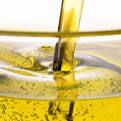Essential Oils for Cancer
Certain essential oils are particularly suited to be used alongside conventional cancer treatments .
Ravintsara (Cinnamomum camphora)
Ravintsara reduces physical and mental asthenia, which in turn helps the patient make decisions and regain self-confidence. During treatment, it counteracts depression. Ravintsara is sedating, promotes sleep, and improves sleep quality and it reduces anxiety. Its antiviral activity and general improvement of the immune response significantly reduces the risk of infection during chemotherapy. Ravintsara reduces most side effects of interferon treatment, such as depression, insomnia, muscle pains, and fatigue. It reduces joint pains and stiffness caused by antiaromatase-type-anti-hormonal treatment for breast cancer. At the end of classical treatment, it stimulates the patient's immune system.
Greenland Moss (Ledum Groenlandicum)
Greenland Moss is very effective for lessening nausea and vomiting during chemotherapy; it reduces pathologically elevated levels of transaminase and gamma -Gt enzymes. It apparently acts as an antitumor agent by inducing cellular apoptosis. After conventional treatments, it is effective for draining the liver and kidneys.
Everlasting (Helichrysum Italicum)
Helichrysum essential oil is extrremely useful after surgery for reducing hematomas, improving healing, preventing cheloid scars, reducing lymphatic edemas following cleaning or dissecting of lymph nodes, and preventing fibrous bands in abdominal surgeries. helichrysum is most useful in breast reconstruction, for its anti-inflammative, painkilling, and antiedematous effect and to eliminate old, hardened hematomas.
Psychologically speaking, it soothes the soul's "bruises" and helps with emotional shocks.
Niaouli (Melaleuca Quinquenervia Viridiflora)
Massages with oils containing Niaouli reduces lymphatic edemas. Niaouli stimulates the immune response. It prevents radio epidermatitis during radiation therapy. It reduces the breast reconstruction period. Niaouli has powerful anti-infectious, antibacterial, antiviral, and antimycotic properties.
Myrrh (Commiphora Molmol)
Myrrh is equally valuable during and after conventional treatment. It drains toxins from the kidneys during and after chemotherapy. Myrrh stimulates the nervous system and has antidepressant properties. It has strong analgesic properties. Myrrh has a very profound effect on a person's entire being by requilibrating the psycho-neuro-endocrino-immunological systems. Myrrh induces cellular apoptosis.
Reference: The Healing Intelligence of Essential Oils: Kurt Schnaubelt, Ph.D.
Articles Latest
- Chamomile Roman - Chamaemelum nobile
- Chamomile Maroc - Ormenis multicaulis
- Chamomile German - Matricaria recutica
- From Biology To Aromatherapy
- Plant Messengers
- Celery Seed-Apium graveolens
- Cedarwood Virginian - Juniperus virginiana
- Cedarwood, Texas- Juniperus ashei - Essential oils
- Cedarwood Atlas- Cedrus atlantica - Essential Oils
- Cassie - Acacia Farnesiana - sweet acacia
- Cassia - Cinnamomum Cassia
- Cascarilla Bark - Croton eluteria
- Carrot Seed- Dacus Carota
- CARDAMON
- CARAWAY
- CANANGA
- CAMPHOR
- CALAMUS
- Calamintha-Calamintha officinalis
- CAJEPUT- Melaleuca cajeputi
- Plant Expression
Articles-Most Read
- Home
- Balsam Canadian - Abies balsamea
- Balsam Peru
- Copaiba Essential Oil
- North America: Tea Tree and Monarda-3
- Basil French - Ocimum basilicum
- Basil Exotic
- North America: Tea Tree and Monarda-2
- Exploring Transcultural Constants
- Thyme Essential Oil
- Balsam Tolu
- Palma Rosa
- The Bioactivity of Essential Oils
- Bay - West Indian - Pimenta racemosa
- Benzoin - Styrax benzoin
- Why Pharmacology Cannot Demonstrate Essential Oil Efficacy
- Exploring Essential Oil Activity The Conventional Way
- Complex information From Plants
- Aromatherapy: An Answer
- Contacts

